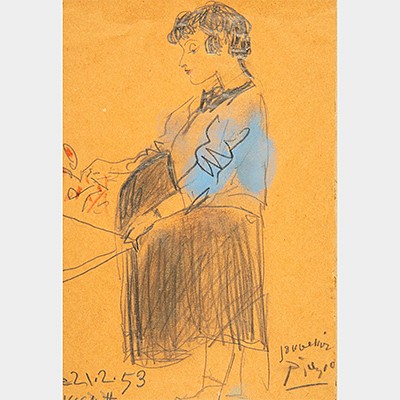MIQUEL BARCELÓ ARTIGUES (Felanitx, Mallorca, 1957). "Le guide du Sahara, 1988. Gouache on paper. Work reproduced in Barceló in Mali (1989) published b
Lot 77
About Seller
Setdart Auction House
Carrer Aragó 346
Barcelona
Spain
Setdart Subastas was born in 2004 and is currently the first online art auction in Spain with solidity, prestige and reliability guaranteed by our more than 60,000 users. Setdart has a young, dynamic and enterprising team ready to successfully manage the purchase and sale of art works through custom...Read more
Categories
Estimate:
EUR€18,000 - EUR€20,000
$19,354.84 - $21,505.38
Absentee vs Live bid
Two ways to bid:
- Leave a max absentee bid and the platform will bid on your behalf up to your maximum bid during the live auction.
- Bid live during the auction and your bids will be submitted real-time to the auctioneer.
Bid Increments
| Price | Bid Increment |
|---|---|
| EUR€0 | EUR€10 |
| EUR€200 | EUR€25 |
| EUR€500 | EUR€50 |
| EUR€1,000 | EUR€100 |
| EUR€3,000 | EUR€200 |
| EUR€5,000 | EUR€500 |
| EUR€10,000 | EUR€1,000 |
| EUR€20,000 | EUR€2,000 |
| EUR€50,000 | EUR€5,000 |
About Auction
By Setdart Auction House
Sep 20, 2021
Set Reminder
2021-09-20 08:00:00
2021-09-20 08:00:00
America/New_York
Bidsquare
Bidsquare : CONTEMPORARY ART
https://www.bidsquare.com/auctions/setdart-auction-house/contemporary-art-7482
Setdart Auction House sofia@setdart.com
Setdart Auction House sofia@setdart.com
- Lot Description
MIQUEL BARCELÓ ARTIGUES (Felanitx, Mallorca, 1957). "Le guide du Sahara, 1988. Gouache on paper. Work reproduced in Barceló in Mali (1989) published by Bischofberger. With labels on the back from the Galería Guillermo de Osma (Madrid). Signed and dated in the lower right corner. Measurements: 50 x 65 cm; 66 x 82 cm (frame). In the manner of a still life, the image composed by a diluted and rapid brushstroke, Barceló presents us with a guide to the Sahara, accompanied by three small skulls. In 1988 Barceló travelled to the Sahara, establishing his studio in Mali. It was at this point in his life that he completed a process of artistic change, in which the artist moved away from more figurative elements, focusing on a more synthetic, abstract and expressive language. Known as the period of his white paintings, this particular work shows the introduction of this tonality, dominated by the presence of black, and figuration, making it a work in transit, in which we can appreciate the aesthetic evolution that the artist himself culminated in the Sahara. The work is reproduced in the catalogue Barceló in Mali, published by Bischofberger, the gallery with which Barceló began to work exclusively in 1984. Only a year after meeting Bruno Bischofberger in Naples. A painter and sculptor, Barceló began his training at the School of Arts and Crafts in Palma de Mallorca, where he studied between 1972 and 1973. In 1974, at the age of seventeen, he made his individual debut at the Galería Picarol in Mallorca. That same year he moved to Barcelona, where he enrolled at the Sant Jordi School of Fine Arts, and made his first trip to Paris. In the French capital he discovered the work of Paul Klee, Fautrier, Wols and Dubuffet, as well as "art brut", a style that was to exert an important influence on his first paintings. During these years he reads extensively, and is enriched by works as diverse as the writings of Breton and the surrealists, Lucio Fontana's "White Manifesto" and Arnold Hauser's "Social History of Literature and Art". In 1976 he held his first solo exhibition in a museum: "Cadaverina 15" at the Museum of Mallorca, consisting of a montage of 225 wooden boxes with glass lids, with decomposing organic materials inside. That same year, back in Mallorca, he joined the Taller Lunàtic group and took part in its social, political and cultural protest actions. In 1977 he made a second trip to Paris, and also visited London and Amsterdam. That same year he exhibits for the first time in Barcelona, and meets Javier Mariscal, who becomes one of his best friends in the city. Together with him and the photographer Antoni Catany, as a member of the group "Neón de Suro", he takes part in exhibitions in Canada and California, and collaborates with the publication of the magazine of the same name. It was also in 1977 that he received his first large-scale painting commission: a mural for the dining room of a hotel in Cala Millor, Mallorca. The following year, at the age of twenty-one, he sold his first works to some collectors and galleries, and finally moved to Barcelona. His international recognition began in the early eighties, giving a definitive boost to his career with his participation in the São Paulo Biennial (1981) and the Documenta in Kassel (1982). In 1986 he was awarded the Premio Nacional de Artes Plásticas, and since then his work has received numerous awards, such as the Prince of Asturias Award for the Arts (2003) and the Sorolla Prize from the Hispanic Society of America in New York (2007). Barceló is currently represented in the most important art museums in the world, such as the MoMA in New York, the Centre Pompidou in Paris, the Guggenheim in Bilbao, etc.
- Shipping Info
-
In-house shipping available. Please inquire at admin@setdart.com.
-
- Buyer's Premium



 EUR
EUR CAD
CAD AUD
AUD GBP
GBP MXN
MXN HKD
HKD CNY
CNY MYR
MYR SEK
SEK SGD
SGD CHF
CHF THB
THB

















